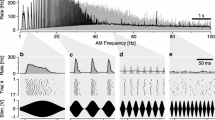Summary
In order to examine the role of particular identified auditory neurons of the cricket,Gryllus bimaculatus, in orientation to a sound source, a method has been developed by which intracellular recordings can be made while the animal walks on an air-suspended sphere, which is rotated by the leg movements (Fig. 1). The angular velocities of sphere rotation were found to depend on the direction of incident sound, on its intensity and frequency and on the temporal pattern of the sound stimulus (Figs. 2, 3).
While the cricket was walking, auditory neurons discharged extra action potentials, not correlated with the sound stimulus, and the neuronal response to the sound itself was reduced (Figs. 4, 5).
Suppressing the spike activity by hyperpolarization of a local neuron in the prothoracic ganglion (ON1) reduced in some animals the tendency to turn toward the sound source on the side of the ear that excites the ON1 (Figs. 6–8). Hyperpolarization of a neuron that ascends from the prothoracic ganglion into the brain (AN1), while sound was presented to the ear that excites this neuron, caused all animals to reverse direction; that is, they turned away from the sound source and from the side of the inactivated AN1 (Figs. 9, 10). Hyperpolarization of another ascending neuron (AN2) caused a reduction in turning velocity in half of the animals; but this effect occurred only with high sound pressure levels, and the direction of walking was not reversed (Figs. 11, 12).
From the influences on turning tendency observed in these experiments, it appears that the paired AN1s (and possibly the AN2s at high intensities) may provide inputs to a central comparator that dictates turning tendency in phonotaxis.
Similar content being viewed by others
References
Atkins GS, Ligman F, Burghardt F, Stout FJ (1984) Changes in phonotaxis by the female cricketAcheta domesticus after killing identified acoustic interneurons. J Comp Physiol A 154:795–804
Casaday GB, Hoy RR (1977) Auditory interneurons in the cricketTeleogryllus oceanicus: physiological and anatomical properties. J Comp Physiol 121:1–13
Dahmen HJ (1980) A simple apparatus to investigate the orientation of walking insects. Experientia 36:685–687
Godden DH, Graham D (1984) A preparation of the stick insectCarausius morosus for recording intracellularly from identified neurones during walking. Physiol Entomol 9:275–286
Graham D (1985) Pattern and control of walking in insects. Adv Insect Physiol 18:31–140
Hedwig B (1986) On the role in stridulation of plurisegmental interneurons of the acridid grasshopperOmocestus viridulus L. J Comp Physiol A 158:429–444
Huber F, Thorson J (1985) Cricket auditory communication. Sci Am 253:60–68
Kien J (1983) The initiation and maintenance of walking in the locust: an alternative to the command concept. Proc R Soc Lond B 219:137–174
Kleindienst HU, Koch UT, Wohlers DW (1981) Analysis of the cricket auditory system by acoustic stimulation using a closed sound field. J Comp Physiol 141:283–296
Kramer E (1975) Orientation of the male silkmoth to the sex attractant Bombykol. In: Denton DA, Coghlan IP (eds) Olfaction and taste. Academic Press, New York, pp 329–355
Moiseff A, Hoy RR (1983) Sensitivity to ultrasound in an identified auditory interneuron in the cricket: a possible neural link to phonotactic behavior. J Comp Physiol 152:155–167
Nolen TG, Hoy RR (1984) Initiation of behavior by single neurons: the role of behavioral context. Science 226:992–994
Popov AV, Markovich AM, Andjan AS (1978) Auditory interneurons in the prothoracic ganglion of the cricketGryllus bimaculatus. J Comp Physiol 126:183–192
Regen J (1926) Über die Beeinflussung der Stridulation vonThamnotrizon apterus durch künstlich erzeugte Töne und verschiedenartige Geräusche. Sitz Ber Akad Wiss Wien Math Nat Kl 135:329–368
Robertson RM, Pearson KG (1982) A preparation for the intracellular analysis of neuronal activity during flight in the locust. J Comp Physiol 146:311–320
Ronacher B (1986) Auslösung von Drehung und Gesangsantwort der Männchen vonChorthippus biguttulus durch den Weibchengesang: Eingrenzung der notwendigen Nervenbahnen durch Ausschaltexperimente. In: Elsner N, Rathmayer W (eds) Sensomotorik. Identifizierte Neurone. Thieme, Stuttgart, p 143
Schildberger K (1984) Temporal selectivity of identified auditory neurons in the cricket brain. J Comp Physiol A 154:171–185
Schildberger K, Milde JJ, Hörner M (1988) The function of auditory neurons in cricket phonotaxis II. Modulation of auditory responses during locomotion. J Comp Physiol A 163:633–640
Schmitz B, Scharstein H, Wendler G (1982) Phonotaxis inGryllus campestris L. J Comp Physiol 148:431–444
Selverston AI, Kleindienst HU, Huber F (1985) Synaptic connectivity between cricket auditory interneurons as studied by selective photoinactivation. J Neurosci 5:1283–1292
Stabel J, Wendler G (1986) Akustische Interneurone und das Vorzeichen der Phonotaxis. In: Elsner N, Rathmayer W (eds) Sensomotorik. Identifizierte Neurone. Thieme, Stuttgart, p 145
Stout J, Gerard G, Hasso S (1976) Sexual responsiveness mediated by the corpora allata and its relationship to phonotaxis in the female cricket. J Comp Physiol 108:1–9
Stout JF, DeHaan CH, McGhee RW (1983) Attractiveness of the maleAcheta domesticus calling song to females. I. Dependence on each of the calling song features. J Comp Physiol 153:509–521
Stout JF, Atkins G, Burghardt F (1985) The characterization and possible importance for phonotaxis of L-shaped ascending acoustic interneurons in the cricket. In: Kalmring K, Elsner N (eds) Acoustic and vibrational communication in insects. Parey, Berlin Hamburg, pp 89–100
Thorson J, Weber T, Huber F (1982) Auditory behavior of the cricket. J Comp Physiol 146:361–378
Weber T, Thorson J, Huber F (1981) Auditory behavior of the cricket. J Comp Physiol 141:215–232
Wiese K, Eilts K (1985) Functional potential of recurrent lateral inhibition in cricket audition. In: Kalmring K, Elsner N (eds) Acoustic and vibrational communication in insects. Parey, Berlin Hamburg, pp 33–40
Wohlers DW, Huber F (1978) Intracellular recording and staining of cricket auditory interneurons. J Comp Physiol 127:11–28
Wohlers DW, Huber F (1982) Processing of sound signals by six types of neurons in the prothoracic ganglion of the cricketGryllus campestris L. J Comp Physiol 146:161–173
Author information
Authors and Affiliations
Rights and permissions
About this article
Cite this article
Schildberger, K., Hörner, M. The function of auditory neurons in cricket phonotaxis. J. Comp. Physiol. 163, 621–631 (1988). https://doi.org/10.1007/BF00603846
Accepted:
Issue Date:
DOI: https://doi.org/10.1007/BF00603846




